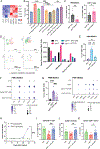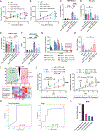GLI2 Facilitates Tumor Immune Evasion and Immunotherapeutic Resistance by Coordinating WNT and Prostaglandin Signaling
- PMID: 39970333
- PMCID: PMC12048270
- DOI: 10.1158/0008-5472.CAN-24-1130
GLI2 Facilitates Tumor Immune Evasion and Immunotherapeutic Resistance by Coordinating WNT and Prostaglandin Signaling
Abstract
Therapeutic resistance to immune checkpoint blockade has been commonly linked to the process of mesenchymal transformation (MT) and remains a prevalent obstacle across many cancer types. An improved mechanistic understanding for MT-mediated immune evasion promises to lead to more effective combination therapeutic regimens. Herein, we identified the hedgehog transcription factor, GLI2, as a key node of tumor-mediated immune evasion and immunotherapy resistance during MT. GLI2 generated an immunotolerant tumor microenvironment through the upregulation of WNT ligand production and increased prostaglandin synthesis. This pathway drove the recruitment, viability, and function of granulocytic myeloid-derived suppressor cells while also impairing type I conventional dendritic cell, CD8+ T-cell, and NK cell functionality. Pharmacologic inhibition of EP2/EP4 prostaglandin receptor signaling or WNT ligand secretion each reversed a subset of the immunomodulatory effects of GLI2 and prevented primary and adaptive resistance to anti-PD-1 immunotherapy, respectively. A transcriptional GLI2 signature correlated with resistance to anti-PD-1 immunotherapy in patients with stage IV melanoma. Together, these findings provide a translational roadmap to direct combination immunotherapies in the clinic. Significance: WNT and prostaglandin signaling generate an immunotolerant environment in GLI2-active tumors and can be targeted as a component of immunotherapeutic combination strategies to overcome resistance in tumors exhibiting mesenchymal plasticity.
©2025 American Association for Cancer Research.
Conflict of interest statement
Figures







Update of
-
Gli2 Facilitates Tumor Immune Evasion and Immunotherapeutic Resistance by Coordinating Wnt Ligand and Prostaglandin Signaling.bioRxiv [Preprint]. 2024 Apr 1:2024.03.31.587500. doi: 10.1101/2024.03.31.587500. bioRxiv. 2024. Update in: Cancer Res. 2025 May 2;85(9):1644-1662. doi: 10.1158/0008-5472.CAN-24-1130. PMID: 38617347 Free PMC article. Updated. Preprint.
References
MeSH terms
Substances
Grants and funding
LinkOut - more resources
Full Text Sources
Molecular Biology Databases
Research Materials

